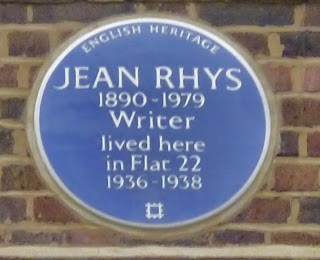Chelsea is steeped in literary history and literary associations, and the images below represent just some choice ones, but are by no means meant to be fully comprehensive.
104 Cheyne Walk:
'HILAIRE
BELLOC
1870–1953
Poet, essayist
and historian
lived here
1900–1905'
Paulton's House, Paulton's Square, where this plaque was unveiled at around the same time as the Elizabeth Bowen plaque in Clarendon Terrace, Regents Park in March 2012:
'JEAN RHYS
1890–1979
Writer
lived here
[with her literary agent]
in Flat 22
1936–1938'
28 Mallord Street:
'This house
was built for
AUGUSTUS
JOHN
1878–1961
Painter'
13 Mallord Street:
'A. A.
MILNE
1882–1956
Author
lived here'
53 Old Church Street. I half expected to find a blue plaque saying John Betjeman had lived here, but things seem to have taken over.
24 Cheyne Row, now owned by the National Trust:
'THOMAS CARLYLE
LIVED AT 24 CHEYNE ROW 1834–1881
THIS TABLET WAS ERECTED BY THE CARLYLE SOCIETY'
This house was originally No 5. The plaque was sculpted by Benjamin Creswick in 1885 after a design by C. F. A Voysey.
22 Upper Cheyne Row:
'LEIGH HUNT
1784–1859
Essayist & Poet
Lived Here'
On, then, to Dr John Samuel Phene, who published a few obscure books: On Prehistoric Traditions and Customs in Connection with Sun and Serpent Worship, and On an Age of Colossi. The British Library has several manuscripts that he wrote to the Committee of the Literary Fund under the (more correct) surname John S. Phené.
I also find it interesting that the Bibliothèque nationale de France has a five-page paper of his about the behaviour of cave men in western Europe:
'Auteur(s) : Phené, John S. (Dr)
Titre(s) : Association française pour l'avancement des sciences. Le Dr John S. Phené,... Sur les coutumes des hommes des cavernes dans l'Europe occidentale. Séance du 21 août 1875 [Texte imprimé]
Publication : Paris : au Secrétariat de l'Association, 1875
Description matérielle : In-8° , 5 p.'
Titre(s) : Association française pour l'avancement des sciences. Le Dr John S. Phené,... Sur les coutumes des hommes des cavernes dans l'Europe occidentale. Séance du 21 août 1875 [Texte imprimé]
Publication : Paris : au Secrétariat de l'Association, 1875
Description matérielle : In-8° , 5 p.'
Dr Phene built a house on the corner of Oakley Street and Upper Cheyne Row apparently modelled on his French family's home, the Chateau de Savenay. The front of the building is said to have had 'writhing' gods and godesses, busts of royalty, etc, and was painted red and yellow with bits of gold. Parts of that description (but not the colours) can, I think, be seen in photos here, although unless there's some joke I don't understand, I think Dickens's Miss Havisham has been confused with a Miss Faversham in the link here: The Library Time Machine.
Sad to say, Dr Phene's house was bulldozed away long ago, although the pub he built, the Phene Arms, is preserved.
33 Oakley Gardens is diagonally opposite the Phene:
'GEORGE
GISSING
1857–1903
Novelist
lived here
1882–1884'
87 Oakley Street:
'JANE
FRANCESCA,
LADY WILDE
"SPERANZA"
1821–1896
Poet and Essayist
lived here
1887–1896'
'DANTE GABRIEL ROSSETTI'
In Chelsea Embankment Gardens, in front of his home at 16 Cheyne Walk where he lived from 1862 until his death in 1882, is the Rossetti Fountain: designed by John Pollard Seddon, sculpted by Ford Maddox Brown, and unveiled by William Holman Hunt.
His hands rest on his Dante and his Circle and Ballads and Sonnets.
4 Cheyne Walk:
'GEORGE
ELIOT
1819–1880
NOVELIST
died here'
34 Tite Street:
'OSCAR
WILDE
1854–1900
wit and
dramatist
lived here'
And this seems like the right time to include this image. I'm thinking, of course, of the famous occasion when Wilde said he wished he'd said something James McNeill Whistler (1834–1903) had said, and Whistler replied 'You will, Oscar, you will.'
Whistler's statue is on Cheyne Walk, on the corner of Battersea Bridge Road, and although intended to commemorate the centenary of his death, wasn't in fact erected here until 2005.
23 Tedworth Square:
SAMUEL L.
CLEMENS
"MARK TWAIN"
1835–1910
American Writer
lived here in
1896–7'.

































No comments:
Post a Comment